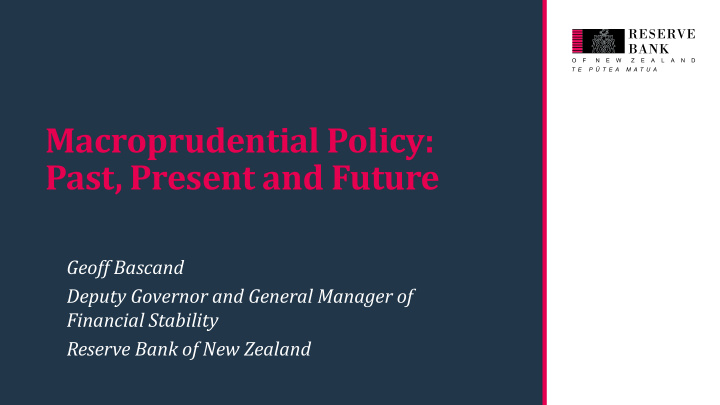



Macroprudential Policy: Past, Present and Future Geoff Bascand Deputy Governor and General Manager of Financial Stability Reserve Bank of New Zealand
Outline • Why are we bringing back direct lending restrictions? • Financial stability is important for wellbeing. • Macroprudential policy is part of how we safeguard financial stability. • My talk will cover • How does macroprudential policy mitigate risks? • Has the Reserve Bank’s macroprudential policy enhanced stability? Were there any side effects? • What is our strategy for governing and operating the tools? 2
Maintaining financial stability Identify and monitor risks; support effective self and market discipline Establish rigorous baseline requirements, and adapt as necessary Minimise the costs of institutional distress or failure 3
Pro-cyclicality of financial risks Figure 1: Boom bust financial cycles Reduced Greater lending lending Bank Banks Asset Asset funding adopt prices go prices go same costs go up down strategy up Boom Bust Banks Lending need Defaults Defaults go standad down more go up falls capital 4
Credit & housing bubbles worsen recessions Percentage change in real GDP per capita 10 10 Recession 8 8 Figure 2: Bubble, low credit 6 6 Bubble, high credit The role of housing 4 4 bubbles and 2 2 credit in 0 0 recessions (1870-2013) -2 -2 -4 -4 Source: Jorda et al . -6 -6 0 1 2 3 4 5 5 Years from crisis
Role of macroprudential policy Macroprudential policy… • …Is a part of our financial stability framework • … Complements baseline prudential policy (e.g. capital) • …Builds additional protection when risks are high • …Interacts with monetary policy • Macroprudential and monetary polices tend to be complementary • …as with all regulation, comes with costs. 6
Regulatory toolkit Crisis Management Crisis Prevention Purpose Relevant tools Impact on financial system resilience Impact on wider economy More resilient households and banks Macroprudential policy Borrower restrictions reduce potential severity of an economic (LVRs) downturn Reduce risk that the Reduced losses in a severe economic Supervision, oversight and disclosure financial system amplifies a downturn severe economic downturn Lowers incentives on banks to Capital and liquidity deleverage in a downturn; supports instruments higher credit supply and economic (CCyB/SCR) activity Capital buffers Prudential policy Banks remain solvent through the Maintains market confidence Liquidity policy Maintain baseline resilience economic cycle and lowers risk of sudden increases in of the financial system funding costs for households, Governance and local businesses and the economy incorporation Collateral standards Banks remain functioning parts Maintains availability of credit and Manage and limit impact of Outsourcing of financial system banking services necessary for distress or failure economic activity Open Bank Resolution Mitigates costs for creditors and taxpayers Minimum capital Losses absorbed first by shareholders 7
Use of LVR tool increased after GFC • New Zealand among the leaders in macroprudential policy. • The GFC has made the world more conscious of financial stability risks. • Borrower restrictions have gained acceptance internationally. 8
Review: LVR policy increased bank resilience % % 100 100 Figure 3: 90 90 Estimated 80 80 mortgage losses 70 70 as share of housing capital 60 60 requirement in a 50 50 downturn. 40 40 30 30 20 20 10 10 0 0 9 Current Counterfactual
Mitigation of economic downturns • Internationally, the GFC’s effect on economic welfare was worsened by • High household debts • House price declines • LVR restrictions will mitigate a downturn because they • Reduce households debts • Soften a potential house price fall 10
LVR policy design mitigated impact on FHBs % % 80 80 Share of all first home buyer lending Figure 4: 70 70 Share of all high-LVR lending Share of first 60 60 home buyer high-LVR lending 50 50 40 40 30 30 20 20 10 10 0 0 11 2014 2015 2016 2017 2018
Other policy tensions and limitations • LVR exemptions mitigated tensions with other public policy areas. • Regional LVR policy can produce unintended spill-overs. • Low disintermediation of risky lending to non-bank lenders. Lessons: • Good LVR design can help to mitigate tensions with other public policy. • Importance of consultation around related policies. • Macroprudential policy is not a tool for social objectives. 12
Principles of governance • Operational independence • Visible short-term costs vs. long-run, dispersed benefits • Independence particularly important for borrower tools • Transparency is needed for accountability • Governance board model • An alternative is interagency committee, but may undermine accountability. 13
Operational strategy Systemic risk Policy Policy choice monitoring assessment - Risk of a - Interaction with - Consultation correction in the baseline policy - Decision credit cycle - Bank-based vs - Ongoing - Bank resilience borrower-based assessment tools. - Feedback with economy 14
LVR policy Outlook • LVR restrictions unchanged in the May FSR • Easing in the LVR policy over time if risks decline • Full removal vs. neutral LVR setting? • Interaction between capital review and LVR policy • Higher capital suggests less active use of LVRs • However, capital proposals and LVRs are complementary policies • Capital proposals include a counter cyclical capital buffer that could be released in recession 15
Conclusion • Macroprudential policy helps to safeguard financial stability. • Our strategy for macroprudential policy is shaped by • Our experience with the LVR tool • International evidence • Our strategy is a starting point for the Government’s review of the macroprudential framework. 16
Recommend
More recommend